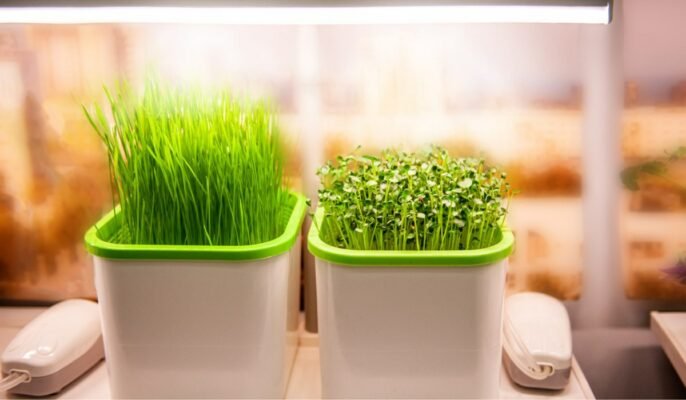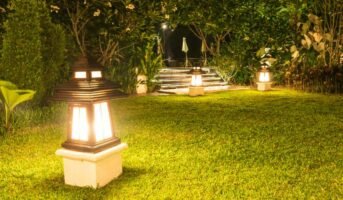Grow lights are essential for indoor gardening, providing artificial illumination to plants. These specially designed lights replicate the natural sunlight required for plant growth. It makes them ideal for areas with limited access to sunlight. With their adjustable intensity and spectrum, grow lights enable gardeners to customise the light conditions and promote healthy photosynthesis. Read the article to understand the definition and purpose of grow lights.
See also: Popular gardening ideas for home
Source: Pinterest (Inspire Uplift)
Grow light: An overview
Grow lights are special lights that are used to help plants grow indoors all year long. They are like artificial sunlight for your plants. These lights come in different colours and strengths to suit the needs of different plants. They are helpful when you have houseplants in rooms without much natural light.
The grow lights use electricity to produce light that plants can use for photosynthesis. This process helps the plants grow and thrive. Some light colours, like red, are great for plants that produce fruits and flowers. And blue light is good for plants still growing their leaves and stems.
Grow light: Types
Incandescent grow light
Source: Pinterest (Succulent City)
Incandescent grow light produces light by heating a filament inside a glass bulb. They emit a broad spectrum of light that includes warm and cool colours, which is beneficial for plant growth. They are readily available and relatively inexpensive compared to other grow lights.
Drawbacks
- Inefficient energy usage and high heat output.
- Limited spectrum, not optimised for plant growth.
- Short lifespan and frequent replacement required.
- Limited intensity, not suitable for larger or dense plant setups.
- Overall higher operating costs compared to other options.
Fluorescent grow light
Source: Pinterest (Gardener’s Supply Company)
Fluorescent grow light consists of long, narrow tubes containing gas and a phosphor coating that emits light when the gas is excited. They come in different types, including T5, T8, and compact fluorescent light (CFL), each offering different light output and efficiency.
Fluorescent lights are relatively energy efficient and produce less heat compared to incandescent lights. They are suitable for seedlings, young plants, and low-light plants, as they provide a balanced spectrum of light necessary for photosynthesis. Fluorescent lights are relatively affordable and widely available.
Drawbacks
- Lower light intensity compared to other options.
- Limited spectrum, not ideal for all stages of plant growth.
- Less energy-efficient compared to newer technologies.
- Bulbs need to be replaced periodically.
- Not suitable for high-light-demanding plants or larger growing areas.
High-intensity discharge (HID) grow light
HID grow light uses an electric arc to produce light and includes metal halide (MH) and high-pressure sodium (HPS) lights. They are highly efficient and provide a high-intensity light output, making them suitable for plants in all growth stages. HID lights cover a wide spectrum of light, including both blue and red wavelengths required for optimal plant growth. They are commonly used in larger indoor gardening setups and commercial operations.
Drawbacks
- High energy consumption and heat output.
- Requires a ballast for operation, adding complexity.
- Bulbs have a shorter lifespan and require frequent replacement.
- Emit a significant amount of heat, requiring additional cooling measures.
- Bulky and may require extra space for installation.
Light-emitting diode (LED) grow light
Source: Pinterest (VivaTerra)
LED grow light uses light-emitting diodes to produce light in specific wavelengths. They are highly energy efficient, converting more electricity into usable light and lowering electricity costs. LED lights can be customised to emit specific wavelengths that correspond to the different growth stages of plants, promoting optimal photosynthesis. They have a longer lifespan than other grow lights and require less frequent replacement.
Drawbacks
- Higher upfront cost compared to other options.
- Requires careful selection to ensure proper spectrum for plant needs.
- Some cheaper models may have limited intensity or coverage.
- Possibility of inconsistent light distribution without proper design.
- Potential for LED burnout or malfunction, requiring replacement.
Factors to consider when choosing grow lights
- Light spectrum: ensure the grow lights provide the necessary spectrum for different stages of plant growth.
- Light intensity: Consider the light output and coverage area to meet the plant’s light requirements.
- Energy efficiency: Opt for energy-efficient LED lights to save electricity and reduce costs.
- Heat output: Consider the heat emitted by the lights and ensure it won’t harm the plants or require additional cooling.
- Coverage area: Determine the size of the area you need to cover and choose lights that can adequately illuminate it.
- Durability and lifespan: Look for lights with a long lifespan and sturdy construction for reliable use.
- Control options: Consider light with adjustable settings for intensity, timing, and spectral output.
- Budget: Set a budget and find lights that offer the best value for your investment.
FAQs
Why do plants need to grow lights?
Plants need light for photosynthesis, the process through which they convert light energy into chemical energy to fuel their growth. Grow lights provide the required light spectrum and intensity when sunlight is insufficient or unavailable.
How far should grow lights be from plants?
The distance between grow lights and plants depends on the light intensity and the growth stage of the plants. Generally, most grow lights should be placed 12-36 inch away from the plants to avoid light burn and optimise light absorption.
Can grow lights replace natural sunlight?
While grow lights can provide the necessary light spectrum for plant growth, they cannot completely replace natural sunlight. Sunlight provides a broader light spectrum and varying intensities that are challenging to replicate with artificial lighting alone.
Are there any safety considerations when using grow lights?
Yes, safety is important when using lights. Here are a few of them: (1) Avoid overloading electrical circuits. (2) Ensure proper ventilation to prevent heat buildup. (3) Follow the manufacturer's instructions regarding installation, distance and usage. (4) It's also essential to use lights specifically designed for horticulture purposes.
Can I use regular household light bulbs as grow lights?
Regular household light bulbs are not ideal as grow lights because they often lack the required light spectrum and intensity for optimal plant growth. It is recommended to use specialised grow lights designed for horticultural applications to ensure better results.
| Got any questions or point of view on our article? We would love to hear from you. Write to our Editor-in-Chief Jhumur Ghosh at jhumur.ghosh1@housing.com |
Housing News Desk is the news desk of leading online real estate portal, Housing.com. Housing News Desk focuses on a variety of topics such as real estate laws, taxes, current news, property trends, home loans, rentals, décor, green homes, home improvement, etc. The main objective of the news desk, is to cover the real estate sector from the perspective of providing information that is useful to the end-user.
Facebook: https://www.facebook.com/housing.com/
Twitter: https://twitter.com/Housing
Email: editor@housing.com

